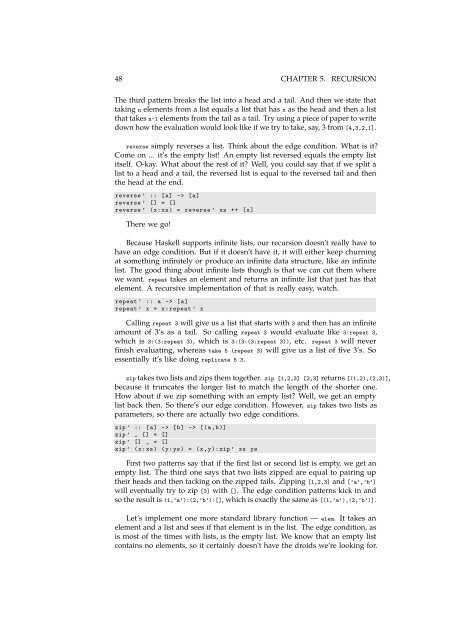You also want an ePaper? Increase the reach of your titles
YUMPU automatically turns print PDFs into web optimized ePapers that Google loves.
48 CHAPTER 5. RECURSION<br />
The third pattern breaks the list into a head and a tail. And then we state that<br />
taking n elements from a list equals a list that has x as the head and then a list<br />
that takes n-1 elements from the tail as a tail. Try using a piece of paper to write<br />
down how the evaluation would look like if we try to take, say, 3 from [4,3,2,1].<br />
reverse simply reverses a list. Think about the edge condition. What is it?<br />
Come on ... it’s the empty list! An empty list reversed equals the empty list<br />
itself. O-kay. What about the rest of it? Well, you could say that if we split a<br />
list to a head and a tail, the reversed list is equal to the reversed tail and then<br />
the head at the end.<br />
reverse ’ :: [a] -> [a]<br />
reverse ’ [] = []<br />
reverse ’ (x:xs) = reverse ’ xs ++ [x]<br />
There we go!<br />
Because Haskell supports infinite lists, our recursion doesn’t really have to<br />
have an edge condition. But if it doesn’t have it, it will either keep churning<br />
at something infinitely or produce an infinite data structure, like an infinite<br />
list. The good thing about infinite lists though is that we can cut them where<br />
we want. repeat takes an element and returns an infinite list that just has that<br />
element. A recursive implementation of that is really easy, watch.<br />
repeat ’ :: a -> [a]<br />
repeat ’ x = x: repeat ’ x<br />
Calling repeat 3 will give us a list that starts with 3 and then has an infinite<br />
amount of 3’s as a tail. So calling repeat 3 would evaluate like 3:repeat 3,<br />
which is 3:(3:repeat 3), which is 3:(3:(3:repeat 3)), etc. repeat 3 will never<br />
finish evaluating, whereas take 5 (repeat 3) will give us a list of five 3’s. So<br />
essentially it’s like doing replicate 5 3.<br />
zip takes two lists and zips them together. zip [1,2,3] [2,3] returns [(1,2),(2,3)],<br />
because it truncates the longer list to match the length of the shorter one.<br />
How about if we zip something with an empty list? Well, we get an empty<br />
list back then. So there’s our edge condition. However, zip takes two lists as<br />
parameters, so there are actually two edge conditions.<br />
zip ’ :: [a] -> [b] -> [(a,b)]<br />
zip ’ _ [] = []<br />
zip ’ [] _ = []<br />
zip ’ (x:xs) (y:ys) = (x,y): zip ’ xs ys<br />
First two patterns say that if the first list or second list is empty, we get an<br />
empty list. The third one says that two lists zipped are equal to pairing up<br />
their heads and then tacking on the zipped tails. Zipping [1,2,3] and [’a’,’b’]<br />
will eventually try to zip [3] with []. The edge condition patterns kick in and<br />
so the result is (1,’a’):(2,’b’):[], which is exactly the same as [(1,’a’),(2,’b’)].<br />
Let’s implement one more standard library function — elem. It takes an<br />
element and a list and sees if that element is in the list. The edge condition, as<br />
is most of the times with lists, is the empty list. We know that an empty list<br />
contains no elements, so it certainly doesn’t have the droids we’re looking for.



